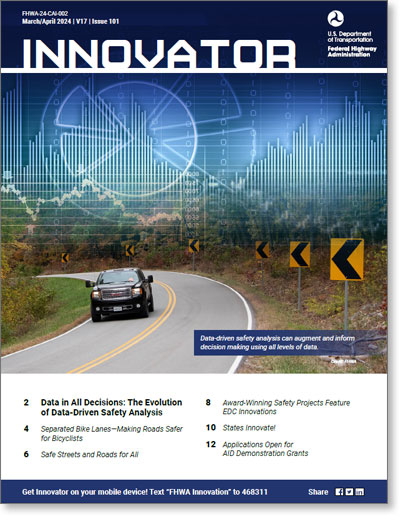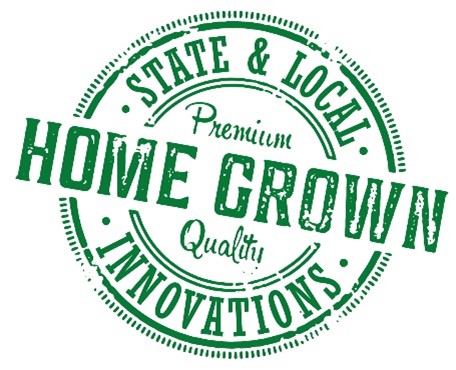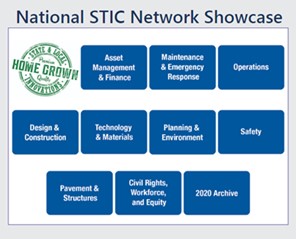March 21, 2024
Innovation of the Month: Rethinking DBE for Design-Build
Rethinking DBE for Design Build allows proposers on Design Build (DB) projects to better align their DBE goal commitments with DB contracting conditions. Because DB projects are not fully designed at the time proposals are required, the details of available subcontracting opportunities are not yet known, and it may be challenging for prime contractors to name DBEs in their commitment plan. In some instances, prime contractors may submit documented good faith efforts instead of a DBE subcontract, thereby limiting opportunities for small, disadvantaged firms.
One solution States have begun using is an open-ended performance plan (OEPP). An OEPP is a modified DBE commitment plan that, instead of naming DBEs to perform specific work at a specific price, allows the proposer to list anticipated work types for planned DBE participation throughout the life of the project. As project details develop, the contractor makes every effort to secure DBE subcontracts in those work area.
Early in their use of DB project delivery, the Ohio Department of Transportation (ODOT) recognized the difficulties of requiring proposers to submit traditional DBE commitment plans with their proposals. Specifically, DBEs were incurring increased risk by committing to work based on limited information since the projects were not yet designed. ODOT’s first use of an OEPP, on the Portsmouth Bypass project, demonstrated the value of this innovative approach. The OEPP allowed prime contractors flexibility in defining DBE opportunities throughout the project's life, resulting in subcontracts that DBEs could actually deliver. As Portsmouth was designed and constructed, new opportunities for DBEs presented themselves, and the contractor met the DBE project goal.
The success of the OEPP on the Portsmouth Bypass project led to ODOT institutionalizing its use in future DB projects. ODOT also found that early collaboration among ODOT staff can help ensure an OEPP’s success. ODOT brings together a core group, which includes engineering, construction, and civil rights personnel, to develop the DB project Request for Proposal (RFP). The inclusion of civil rights staff helps to ensure that the RFP identifies the information contractors need to include in a successful OEPP, such as anticipated DBE work types and required outreach and monitoring activities.
ODOT developed and delivers training focused on OEPP and DB specifically for DBE firms to ensure understanding of DB project deliver and the use of OEPP. ODOT also provides opportunities for DBEs to connect with prime contractors early and often by holding in-person “matchmaking” events and other outreach activities for DBEs prior to award. These events include an overview of the project and what work types will be needed. ODOT has found that these events help DBEs better align their services with project demand and better understand the timeline of when their work might occur. ODOT’s use of OEPPs on DB projects has helped deliver more opportunities for DBE firms, ensuring a more effective DBE program.
Stay up-to-date on this innovation by registering for Rethinking DBE e-bulletins. To learn more about Rethinking DBE for Design Build, please contact Christine Thorkildsen or Eric Ross, FHWA Office of Civil Rights.
WRMS Factsheet Compares Crowdsourcing Approaches for Road Weather Information
Transportation agencies have greater access to vast and varied crowdsourced data sources every day. Knowing how to analyze these data is an important element of any transportation agency’s crowdsourcing plan. This Weather-Responsive Management Strategies (WRMS) factsheet provides a snapshot of three different crowdsourcing approaches used by State and local DOTs, specifically for road weather condition monitoring.
Learn more about how agencies use social media monitoring, third-party smartphone applications, and DOT citizen reporting programs and read comparisons of the techniques across measures including data coverage, error potential, required quality control, and more. Which approaches will fit best within your agency operations?
To learn more about weather-responsive management strategies, please contact David Johnson, FHWA Office of Operations. For more in-depth information on crowdsourcing, contact James Colyar, FHWA Office of Operations, Greg Jones, FHWA Resource Center, or Ralph Volpe, FHWA Resource Center.
New Innovator Now Available!
The March/April issue of Innovator is now available, accessible from your computer, tablet, or mobile phone to optimize your reading experience!
In this issue:

In this issue:
- Data in All Decisions: The Evolution of Data-Driven Safety Analysis
- Separated Bike Lanes—Making Roads Safer for Bicyclists
- Safe Streets and Roads for All
- Award-Winning Safety Projects Feature EDC Innovations
- Applications Open for AID Demonstration Grants
- And more...
Comments? Questions? We'd love your feedback! Drop us a line and let us know what you think.
Read past issues and sign up to receive Innovator by email here, or text "FHWA Innovation" to 468311 to get Innovator on your smartphone.
Discover Home-Grown Innovations from Around the Country

Are you interested in homegrown innovations being used by your peers in other parts of the country? The National STIC Network Showcase provides a summary of STIC Showcase entries from the EDC-7 Virtual Summit.

Learn about the New Hampshire Department of Transportation's Culvert Diffuser project, which implemented Maine DOT research by installing a 3D printed diffuser during a pipe rehabilitation project. The diffuser provided an estimated 40 percent increase in outlet capacity.
Celebrate the ingenuity of your peers and read about these innovations—developed and deployed in-house at transportation agencies nationwide.
Stay Up to Date on the EDC Innovations That Interest You Most

EDC teams are always on the move! If you blink, you could miss out on important webinars, case studies, tools, videos, and more. To never miss information for the EDC innovations that interest you most, visit the subscription page and select the topics you’d like to receive updates on directly from the teams that coordinate them.
Recent bulletins:
NextGen TIM 3/14/24
Sustainable Pavements 3/12/24
Local Aid Support 3/5/24
Upcoming Events
Safety tools and strategies for equitable design
March 27, 2024, 1:00-3:00 ET Register
Equitable Safety Data Analysis
May 22, 2024, 1:00-3:00 ET Register
Roadway Safety for People Experiencing Homelessness
July 24, 2024, 1:00-3:00 ET Register
About EDC
Every Day Counts, a State-based initiative of the Federal Highway Administration's Office of Innovation and Workforce Solutions, works with State, local, and privatesector partners to encourage the adoption of proven and underutilized technologies to deliver transportation projects more efficiently, enhance safety forall users, support a sustainable and resilient infrastructure, and incorporate equity inproject planning and delivery.
EDC News is a weekly publication highlighting successful EDC innovation deployments across the country.
EDC News is published weekly by the FHWA Center for Accelerating Innovation.
Disclaimer: The U.S. Government does not endorse products or manufacturers. Trademarks or manufacturers’ names appear in this document only because they are considered essential to the objective of the document. They are included for informational purposes only and are not intended to reflect a preference, approval, or endorsement of any one product or entity.
Except for the statutes and regulations cited, the contents of this document do not have the force and effect of law and are not meant to bind the States or the public in any way. This document is intended only to provide information regarding existing requirements under the law or agency policies.
Recommended Citation:
U.S Department of Transportation, Federal Highway Administration
EDC News; March 21, 2024
Washington, DC


